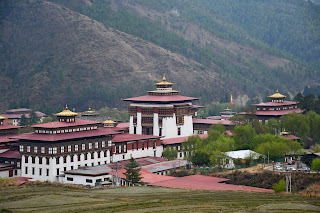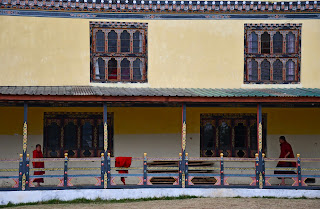Bhutan – Day 1: Arriving in Thimphu
We woke up at 5:30 in the morning for a quick breakfast at the hotel, after which we took a shuttle to the airport. We made our flight with plenty of time to spare; check-in was scheduled for 7:55, but not much started happening until half an hour later. That being the case, I was shocked that the plane took off just around ten minutes later than expected.
Fortune smiled upon us
twice in a row to make this day work perfectly. Firstly, our tour guide had the
presence of mind to check us in early and have us all sit on the left-side of
the plane, which is the side from which the Himalayas are visible when flying
from Kathmandu to Paro. Thimphu does not have an airport due to its formidable
topography, and even Paro is quite difficult to reach. Only a dozen or so
pilots are officially permitted to land there, receiving special training on
how to fly between the mountains in a very precise manoeuvre d’atterrissage.
Our second stroke of
luck came in the form of good weather. The Himalayan peaks rose above the
clouds in their full splendour, with only a single white tuft caught and
unspooled by the sharp tip of Mount Everest. To the right of its dark,
pyramid-like shape, we saw the peak of Lhotse – the fourth tallest mountain in
the world – and further still rose the world’s fifth tallest peak, Makalu.
Since we also spotted Kangchenjunga as we started to descend, we could
congratulate ourselves on flying past 4 of the 5 tallest peaks in the world
(the exception being K2).
Reasons for our
continued amazement kept amassing. The pilot made a superbly clean landing
despite the occasional gusts of wind and uncomfortable angles (looking above
oneself and seeing terraced fields is a rather strange experience). We also
found the airport quite impressive. Built in the decorative national style, the
design incorporates a lot of woodwork, colours, and intricate patterns. Its
massive portraits of the king and his relations also served as our first
introduction to the royal cult. We would familiarise ourselves with this
cultural feature over the following hours and days, finding depictions of the
royals everywhere, from the walls of restaurants and shops to highway signs and
pins worn by hotel staff.
Our first stop in
Bhutan was a little-known temple on the way to Thimphu. Finished relatively
recently, its golden roofs and decorations appear more opulent than the
standard, but of course their historical value is minimal. As is often the case
at less visited temples – which is not infrequent due to Bhutan’s tourist quota
– we had to find a monk to open the doors for us so we could look inside. This
was a job for our local guide Karma; despite our tour guide’s
knowledgeableness, Bhutan requires groups to recruit one from the country. I
believe the price is included in the daily fee tourists pay to stay here.
On that note, we have
been having an ongoing conversation about the local tourist industry. Before
the pandemic, the number of tourists was high and steadily increasing at some
two hundred thousand visitors per year, as compared to a population of around
750,000. This has led everyone and their mother to the same idea: borrow money
to build a hotel. However, many of these hotels now run at perhaps a quarter of
their usual capacity; the one we’re staying at seems to have no more than a
dozen other tourists (and I feel as though even a dozen would be quite a
generous estimate). It is clear something has to change, but no one is sure
how, as a drastic policy reversal would imply loss of face.
Our second stop was by
the famous Tachogang Lhakhang footbridge. In the fifteenth century, there lived
a spiritual leader named Tangtong Gyelpo, whose lifelong ambition was to save
lives by building bridges. Tachogang was but one among the many structures he
erected, but it holds a special place among them as it was entirely
reconstructed from the surviving parts of other suspended bridges built by the yogi.
Upon our arrival in
Thimphu, we visited one of the fields on which traditional archery contests are
held. A national (male) pastime, these involve everything a usual archery
contest does, except Bhutanese shooters aim from much farther away and they
play in teams. Allegedly, arrows do sometimes stray from their course and very
rarely kill their victims. It being a windy day, we thought it best not to
tempt fate for too long.
Continuing in the same
direction and riding the bus up a hill, we made our penultimate stop of the day
at Dechen Phodrang Monastery. It is thought that a dzong (i.e., fortress) used
to stand on the site from around the break of the 13th century, but
the most significant event in its existence was when it was captured by Ngawang Namgyal (frequently referred to as Zhabdrung
Rinpoche), the seventeenth-century unifier of Bhutan. Zhabdrung Rinpoche used
the captured dzong as his summer capital, moving to low-lying Punakha in the
winter – a rotation still practiced by Bhutan’s top spiritual authority, the Je
Khenpo.
It would be somewhat
imprecise to refer to a dzong as a mere fortress though. Wikipedia describes a
dzong as a “fortified monastery,” explaining that dzongs functioned as “religious,
military, administrative, and social centres.” Indeed, when Ngawang Namgyal
instituted a new system of governance in Bhutan (referred to as Choesi), he
enshrined in it a kind of dual control that centres on the spiritual authority
of the Je Khenpo and the secular authority of the Druk Desi. It is no accident
that the language of Bhutan is called Dzongkha – literally “the language of the
dzong:” it has traditionally been the language of the political-religious
elites (though the literary language was Tibetan).
Finally, we rode down
to Thimphu Dzong just in time to see the ritual lowering of the flag for the
night. The ceremony was overseen by a high-ranking lama, a fact that could be
ascertained from his bright grapefruit-coloured habit and matching
flower-shaped hat. Standing to the side were three fancily-clad women with
boat-shaped hats, who provided musical accompaniment as a group of soldiers
marched the folded flag to an inner sanctum. We followed them until we were
permitted no farther, and briefly walked around the dzong’s main temple and
largest courtyard.






















































Comments
Post a Comment